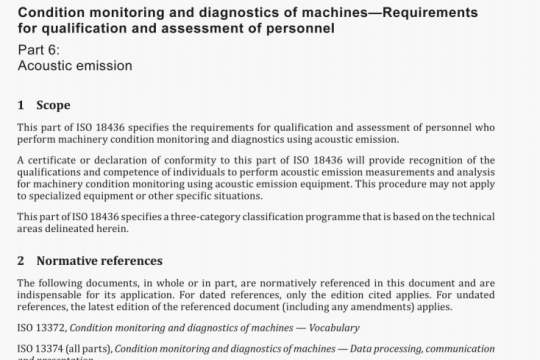ISO 1920-13:2018 pdf free
ISO 1920-13:2018 pdf free.Testing of concrete一Properties of fresh self compacting concrete
The slump-flow test is an indication of the flowability of self- compacting concrete in the absence of obstructions. It is based on the slump test described in ISO 1920-2. The flowability is evaluated by measuring the spreading maximum diameter, dmax, and the time it reaches the spreading diameter of 500 mm, t500. The dmax of spreading is a measure of the self-compacting concrete flow range when subjected to load from its own weight. It is an indication of the yield stress of the self-compacting concrete. The t500 time is a measure of the speed of flow and an indication of the relative viscosity of the self-compacting concrete. The result is an indication of the filling ability of self-compacting concrete.
The fresh concrete is poured into a cone as specified for the ISO 1920-2 slump test. When the cone is withdrawn upwards, the time from commencing upward movement of the cone to when the concrete has flowed to a diameter of 500 mm is measured; this is the t50o time. The largest diameter of the flow spread of the concrete and the diameter of the spread at right angles to it are then measured and the mean is the slump-flow.
Fill the cone in one operation without any agitation or mechanical compaction, and strike off surplus from the top of the cone. Allow the filled cone to stand for not more than 30 s; during this time remove any spilled concrete from the baseplate.
Lift the cone vertically in 1 s to 3 s in one movement without interfering with the flow of concrete. If the t500 time has been requested, start the stop watch immediately the cone ceases to be in contact with the baseplate and record the time taken to the nearest 0,1 s for the concrete to first touch the 500 mm circle
After the flow of concrete has stabilized without disturbing the baseplate or concrete, measure the largest diameter of the flow spread and record as d1 to the nearest 10 mm. Then measure the diameter of the flow spread at right angles to d1 to the nearest 10 mm and record as d2 to the nearest 10 mm. If the difference between d1 and d2 is greater than 50 mm another sample shall be taken and the procedure repeated.ISO 1920-13 pdf download.




